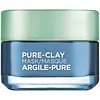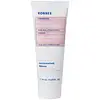What's inside
What's inside
 Key Ingredients
Key Ingredients

 Benefits
Benefits

 Concerns
Concerns

 Ingredients Side-by-side
Ingredients Side-by-side

Water
Skin ConditioningKaolin
AbrasiveGlycerin
HumectantAlcohol Denat.
AntimicrobialIsononyl Isononanoate
EmollientCetearyl Alcohol
EmollientMica
Cosmetic ColorantCI 77891
Cosmetic ColorantStearic Acid
CleansingStearyl Alcohol
EmollientZinc Sulfate
AntimicrobialGlyceryl Stearate Citrate
EmollientCetearyl Glucoside
EmulsifyingSodium Hydroxide
BufferingLaminaria Saccharina Extract
Skin ProtectingPyridoxine Hcl
Skin ConditioningMyristic Acid
CleansingPalmitic Acid
EmollientMoroccan Lava Clay
AbrasiveCapryloyl Glycine
CleansingXanthan Gum
EmulsifyingMontmorillonite
AbsorbentButylene Glycol
HumectantTocopherol
AntioxidantPhenoxyethanol
PreservativeCI 77499
Cosmetic ColorantCI 77510
Cosmetic ColorantLinalool
PerfumingLimonene
PerfumingParfum
MaskingWater, Kaolin, Glycerin, Alcohol Denat., Isononyl Isononanoate, Cetearyl Alcohol, Mica, CI 77891, Stearic Acid, Stearyl Alcohol, Zinc Sulfate, Glyceryl Stearate Citrate, Cetearyl Glucoside, Sodium Hydroxide, Laminaria Saccharina Extract, Pyridoxine Hcl, Myristic Acid, Palmitic Acid, Moroccan Lava Clay, Capryloyl Glycine, Xanthan Gum, Montmorillonite, Butylene Glycol, Tocopherol, Phenoxyethanol, CI 77499, CI 77510, Linalool, Limonene, Parfum
Water
Skin ConditioningGlycerin
HumectantJojoba Esters
EmollientAlcohol Denat.
AntimicrobialGlycolic Acid
BufferingDistarch Phosphate
AbsorbentKaolin
AbrasivePunica Granatum Seed Powder
AbrasiveSimmondsia Chinensis Seed Oil
EmollientIsononyl Isononanoate
EmollientOryza Sativa Bran Oil
EmollientPentylene Glycol
Skin ConditioningCetearyl Alcohol
EmollientGlyceryl Stearate Citrate
EmollientHelianthus Annuus Seed Wax
Skin ConditioningSodium Hydroxide
BufferingSalix Alba Bark Extract
AstringentCaprylyl Glycol
EmollientCitrus Aurantifolia Fruit Extract
Skin ConditioningGlyceryl Caprylate
EmollientHamamelis Virginiana Leaf Extract
Skin ConditioningLactic Acid
BufferingLactobacillus/Punica Granatum Fruit Ferment Extract
Skin ConditioningLeuconostoc/Radish Root Ferment Filtrate
AntimicrobialPanthenol
Skin ConditioningParfum
MaskingPhenoxyethanol
PreservativePotassium Sorbate
PreservativeSodium Benzoate
MaskingSodium Polyacrylate
AbsorbentTetrasodium Glutamate Diacetate
Xanthan Gum
EmulsifyingWater, Glycerin, Jojoba Esters, Alcohol Denat., Glycolic Acid, Distarch Phosphate, Kaolin, Punica Granatum Seed Powder, Simmondsia Chinensis Seed Oil, Isononyl Isononanoate, Oryza Sativa Bran Oil, Pentylene Glycol, Cetearyl Alcohol, Glyceryl Stearate Citrate, Helianthus Annuus Seed Wax, Sodium Hydroxide, Salix Alba Bark Extract, Caprylyl Glycol, Citrus Aurantifolia Fruit Extract, Glyceryl Caprylate, Hamamelis Virginiana Leaf Extract, Lactic Acid, Lactobacillus/Punica Granatum Fruit Ferment Extract, Leuconostoc/Radish Root Ferment Filtrate, Panthenol, Parfum, Phenoxyethanol, Potassium Sorbate, Sodium Benzoate, Sodium Polyacrylate, Tetrasodium Glutamate Diacetate, Xanthan Gum
Ingredients Explained
These ingredients are found in both products.
Ingredients higher up in an ingredient list are typically present in a larger amount.
Alcohol Denat. is an alcohol with a denaturant property. It is created by mixing ethanol with other additives.
This ingredient gets a bad rep because it is irritating and drying - mostly due to its astringent property. Astringents draw out natural oils in tissue, constricting pores and leaving your skin dried out.
However, alcohol denat. is not all that bad.
Due to its low molecular weight, alcohol denat. tends to evaporate quickly. One study on pig skin found half of applied alcohol evaporated in 10 seconds and less than 3% stayed on skin.
This also helps other ingredients become better absorbed upon application.
Studies are conflicted about whether this ingredient causes skin dehydration. One study from 2005 found adding emollients to propanol-based sanitizer decreased skin dryness and irritation. Another study found irritation only occurs if your skin is already damaged.
Small amounts of alcohol are generally tolerated by oily skin or people who live in humid environments.
The rule of thumb is if this alcohol is near the end of an ingredients list, it will probably not affect your skin much.
Also...
This ingredient has antimicrobial and solvent properties.
The antimicrobial property helps preserve products and increase their shelf life. As a solvent, it helps dissolve other ingredients.
Other types of astringent alcohols include:
Learn more about Alcohol Denat.Cetearyl alcohol is a mixture of two fatty alcohols: cetyl alcohol and stearyl alcohol. It is mainly used as an emulsifier. Emulsifiers help prevent the separation of oils and products. Due to its composition, it can also be used to thicken a product or help create foam.
Cetearyl alcohol is an emollient. Emollients help soothe and hydrate the skin by trapping moisture.
Studies show Cetearyl alcohol is non-toxic and non-irritating. The FDA allows products labeled "alcohol-free" to have fatty alcohols.
This ingredient is usually derived from plant oils such as palm, vegetable, or coconut oils. There is debate on whether this ingredient will cause acne.
Due to the fatty acid base, this ingredient may not be Malassezia folliculitis safe.
Learn more about Cetearyl AlcoholGlycerin is already naturally found in your skin. It helps moisturize and protect your skin.
A study from 2016 found glycerin to be more effective as a humectant than AHAs and hyaluronic acid.
As a humectant, it helps the skin stay hydrated by pulling moisture to your skin. The low molecular weight of glycerin allows it to pull moisture into the deeper layers of your skin.
Hydrated skin improves your skin barrier; Your skin barrier helps protect against irritants and bacteria.
Glycerin has also been found to have antimicrobial and antiviral properties. Due to these properties, glycerin is often used in wound and burn treatments.
In cosmetics, glycerin is usually derived from plants such as soybean or palm. However, it can also be sourced from animals, such as tallow or animal fat.
This ingredient is organic, colorless, odorless, and non-toxic.
Glycerin is the name for this ingredient in American English. British English uses Glycerol/Glycerine.
Learn more about GlycerinGlyceryl Stearate Citrate is a citric acid ester of glyceryl stearate.
It is an emulsifier, emollient, and a surfactant.
Emulsifiers help stabilize a product. It does this by preventing certain ingredients from separating. Common ingredients include oils and water, which do not mix naturally. Emulsifiers have properties that help keep ingredients such as these together.
Emollients help soothe and soften the skin. They do this by creating a protective film on your skin. This barrier helps trap moisture and keeps your skin hydrated. Emollients may be effective at treating dry or itchy skin.
Surfactants help gather oils, dirt, and other pollutants from the skin. This helps them to be easily rinsed away.
Learn more about Glyceryl Stearate CitrateIsononyl Isononanoate is a synthetic skin-conditioner and texture enhancer. It is created from nonanoic acid, a fatty acid found in cocoa and lavender oil.
As an emollient, Isononyl Isononanoate helps keep your skin soft and smooth. This is because emollients create a barrier on the skin to trap moisture in.
Isononyl Isononanoate helps give products a velvet feel and improves spreadability.
Learn more about Isononyl IsononanoateKaolin is a clay. It is used for oil control and to help minimize pores. Like other clays, kaolin has the ability to absorb excess sebum or oil. This can help clean out pores and mattify the skin.
Some types of kaolin may have exfoliating properties. When water is added to kaolin, it becomes a paste with small abrasive particles.
Most kaolin is a white color, but may be pink/orange/red depending on where it comes from.
The name 'kaolin' comes from a Chinese village named 'Gaoling'. Kaolin clay comes from rocks rich in kaolinite. Kaolinite, the mineral, has a silicate layered structure. Kaolinite is formed from chemical weathering of aluminum siilicate minerals.
Besides skincare, kaolin is commonly used to make glossy paper, in ceramics, toothpaste, and as medicine to soothe stomach issues.
Learn more about KaolinParfum is a catch-all term for an ingredient or more that is used to give a scent to products.
Also called "fragrance", this ingredient can be a blend of hundreds of chemicals or plant oils. This means every product with "fragrance" or "parfum" in the ingredients list is a different mixture.
For instance, Habanolide is a proprietary trade name for a specific aroma chemical. When used as a fragrance ingredient in cosmetics, most aroma chemicals fall under the broad labeling category of “FRAGRANCE” or “PARFUM” according to EU and US regulations.
The term 'parfum' or 'fragrance' is not regulated in many countries. In many cases, it is up to the brand to define this term.
For instance, many brands choose to label themselves as "fragrance-free" because they are not using synthetic fragrances. However, their products may still contain ingredients such as essential oils that are considered a fragrance by INCI standards.
One example is Calendula flower extract. Calendula is an essential oil that still imparts a scent or 'fragrance'.
Depending on the blend, the ingredients in the mixture can cause allergies and sensitivities on the skin. Some ingredients that are known EU allergens include linalool and citronellol.
Parfum can also be used to mask or cover an unpleasant scent.
The bottom line is: not all fragrances/parfum/ingredients are created equally. If you are worried about fragrances, we recommend taking a closer look at an ingredient. And of course, we always recommend speaking with a professional.
Learn more about ParfumPhenoxyethanol is a preservative that has germicide, antimicrobial, and aromatic properties. Studies show that phenoxyethanol can prevent microbial growth. By itself, it has a scent that is similar to that of a rose.
It's often used in formulations along with Caprylyl Glycol to preserve the shelf life of products.
Sodium Hydroxide is also known as lye or caustic soda. It is used to adjust the pH of products; many ingredients require a specific pH to be effective.
In small amounts, sodium hydroxide is considered safe to use. However, large amounts may cause chemical burns due to its high alkaline.
Your skin has a natural pH and acid mantle. This acid mantle helps prevent harmful bacteria from breaking through. The acid mantle also helps keep your skin hydrated.
"Alkaline" refers to a high pH level. A low pH level would be considered acidic.
Learn more about Sodium HydroxideWater. It's the most common cosmetic ingredient of all. You'll usually see it at the top of ingredient lists, meaning that it makes up the largest part of the product.
So why is it so popular? Water most often acts as a solvent - this means that it helps dissolve other ingredients into the formulation.
You'll also recognize water as that liquid we all need to stay alive. If you see this, drink a glass of water. Stay hydrated!
Learn more about WaterXanthan gum is used as a stabilizer and thickener within cosmetic products. It helps give products a sticky, thick feeling - preventing them from being too runny.
On the technical side of things, xanthan gum is a polysaccharide - a combination consisting of multiple sugar molecules bonded together.
Xanthan gum is a pretty common and great ingredient. It is a natural, non-toxic, non-irritating ingredient that is also commonly used in food products.
Learn more about Xanthan Gum